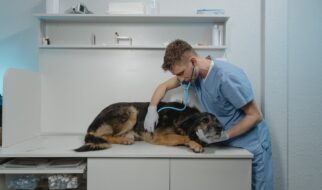If a member of your family cuts themself or is hurt, you’re usually prepared. But what should you do if your cat chokes on a bone or has a seizure? Knowing some basic pet first-aid procedures might make the difference between life and death for your pet. Here are some frequent pet emergencies and what to do before going to the vet.
First Aid Techniques for Pet Emergencies
When you’re on your way, phone the vet to let them know you’re on your way so they can prepare for the vet emergency.
Car Accident
A pained animal is more prone to bite. Unless it’s vomiting, muzzle it first with a scarf, belt, or cloth. Remove the animal off the road by sliding it gently onto a towel or blanket (which should be in your car’s first-aid kit). Don’t try to raise the animal. As it may be in shock, make sure it’s warm. If it seems to have any shattered bones, try not to move it too much.
Poisoning
Many household goods, from antifreeze, pesticides, and aspirin to raisins and sugar-free gum, may be harmful to dogs and cats. But don’t be alarmed. Many of these are treatable. Contact this vet clinic right away.
Choking
If your pet does not have consciousness, open its mouth and use your fingers to clear the thing out. If the animal is awake, use a modified Heimlich technique. Place the pet on its side, placing your hands forward and directly under the ribcage. This may aid in the removal of the object. Get someone else to take you to the vet so you can do this on the way.
Seizures
A seizure will usually pass on its own in around 3 minutes. Your responsibility is to keep the animal safe while this is going on. Remove any moving furniture from the pet’s reach. Please don’t put your hands near the animal’s mouth, and don’t try to pull its tongue out. Contact your veterinarian after the episode has ended.
Bites
If your dog gets bitten by another dog, bandage the wound if it is bleeding. As previously said, an animal in agony is more prone to bite. So, first, muzzle it with a scarf, belt, or towel. As quickly as possible, go to the clinic. A dog bite may cause a lot of hair and dirt to go into the wound. It may develop infected if not cleared out quickly.
Stings
Bee and wasp stings often result in very minimal swelling and irritation. If you are able to see the stinger, scrape it with a credit card or pluck it out with tweezers. An antihistamine can help with some symptoms, but consult your veterinarian about how much to administer. Get the animal to the doctor if you observe swelling on the face or hives all over the body. This might be a serious anaphylactic response and should be treated as an emergency.
Heatstroke
If your pet is panting hard, drooling, having difficulty breathing, or exhibiting other signs of heatstroke, take it to a cool place right away. Wrap a moist, cold towel over its neck and head (not its face). Before transferring the animal to the clinic, carefully spray it off, paying specific attention to the belly. Allowing your pet to cool off too rapidly might be harmful.
To End
Keep your vet’s name, address, and phone number in an address book or a secure spot around the house and on your mobile phone or landline. First, contact your veterinarian. You must notify them that an emergency case is on its way and follow any directions you provide, such as if emergencies are observed in a separate location.



